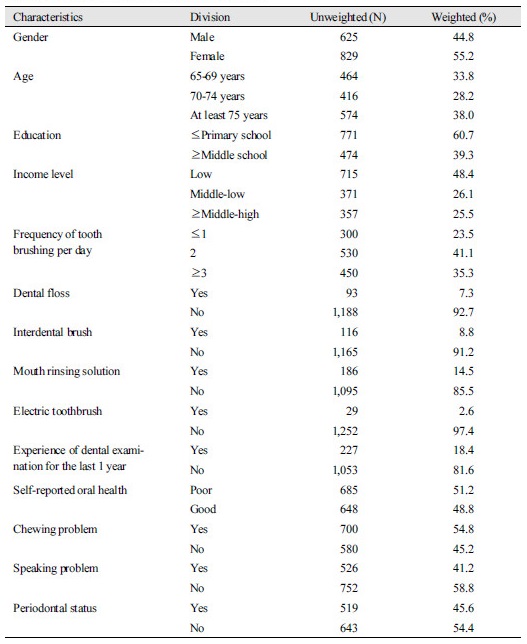Abstract
Objectives: The objective of the study was to review the correlation between self-perceived oral health status and periodontal diseases in elderly Koreans, using data from the 6th (2nd year) Korea National Health and Nutrition Examination Survey (2014). Methods: The subjects for this study were a total of 1,454 elderly people aged 65 years or older who responded to the health questionnaires of the 6th (2nd year) Korea National Health and Nutrition Examination Survey conducted in 2014. Their general characteristics were analyzed using frequency analysis, while a cross-tabulation analysis (2-test) was performed to understand the correlation with periodontal diseases. To clarify any effect of self-perceived oral health status on periodontal diseases, the selected variables were controlled and subsequently analyzed according to the logistic regression analysis. Results: In terms of the difference between elderly people with periodontal disease and those without periodontal disease, higher prevalence rates of periodontal diseases were found in women, those of younger age, those with lower educational and income levels, those with poorer subjective oral health status, those in the presence of chewing discomfort, those who had a toothbrushing frequency of twice per day, and/or those who had received no oral examination over the previous one year. Regarding the effect of self-perceived oral health status on periodontal diseases, 1.78-fold and 1.74-fold higher prevalence rates of periodontal diseases were shown with poorer subjective oral health status and in the presence of chewing discomfort, respectively. Conclusions: Based upon the results above, it is considered that a better understanding of self-perceived oral health status is necessary for a healthy life of the elderly. Furthermore, constant relevant studies and effective prevention programs intended to moderate the progress of or prevent periodontal diseases in the elderly in communities should be performed and implemented for the sake of better quality of life and oral health.
Figures & Tables

Table 1. The general characteristics of the subjects


